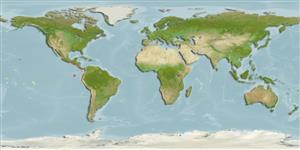>
Eupercaria/misc (Various families in series Eupercaria) >
Haemulidae (Grunts) > Haemulinae
Etymology: Orthopristis: Greek, ortho = straight + Greek, pristis = saw (Ref. 45335).
More on author: Günther.
Environment: milieu / climate zone / depth range / distribution range
Écologie
marin démersal; profondeur 10 - 60 m (Ref. 91172). Tropical; 24°N -
Eastern Pacific: Mexico to Panama, including the Galapagos Islands.
Taille / Poids / Âge
Maturity: Lm ? range ? - ? cm
Max length : 45.0 cm TL mâle / non sexé; (Ref. 9114); common length : 35.0 cm TL mâle / non sexé; (Ref. 9114)
Description synthétique
Clés d'identification | Morphologie | Morphométrie
Body short, compressed, and not very deep (depth contained 2.5 to 3.0 times in standard length); mouth small and terminal, its posterior end located at the same level as the anterior rim of the eye; first gill arch with 19 to 24 gill rakers; dorsal fin very slightly notched, with 12 to 13 spines and 14 to 15 soft rays (XII-XIII, 14-15); second anal spine stronger than third but of equal length; scale series above lateral line oblique; body silvery gray, with wavy, interrupted, gold or copper colored lines that follow the oblique scale series above the lateral line and that run horizontally below it (Ref. 55763).
Inhabits sand and gravel bottoms of coastal waters (Ref. 9114). Important food fish (Ref. 9114).
Life cycle and mating behavior
Maturities | Reproduction | Spawnings | Egg(s) | Fecundities | Larves
Oviparous, distinct pairing during breeding (Ref. 205).
McKay, R.J. and M. Schneider, 1995. Haemulidae. Burros, corocoros, chulas, gallinazos, roncos. p. 1136-1173. In W. Fischer, F. Krupp, W. Schneider, C. Sommer, K.E. Carpenter and V. Niem (eds.) Guia FAO para Identification de Especies para lo Fines de la Pesca. Pacifico Centro-Oriental. 3 Vols. FAO, Rome. (Ref. 9114)
Statut dans la liste rouge de l'IUCN (Ref. 130435)
Menace pour l'homme
Harmless
Utilisations par l'homme
Pêcheries: intérêt commercial mineur
Outils
Articles particuliers
Télécharger en XML
Sources Internet
Estimates based on models
Preferred temperature (Ref.
123201): 19.9 - 28.9, mean 26.4 °C (based on 52 cells).
Phylogenetic diversity index (Ref.
82804): PD
50 = 0.5078 [Uniqueness, from 0.5 = low to 2.0 = high].
Bayesian length-weight: a=0.01072 (0.00658 - 0.01745), b=2.96 (2.83 - 3.09), in cm total length, based on LWR estimates for this species & (Sub)family-body (Ref.
93245).
Niveau trophique (Ref.
69278): 3.6 ±0.5 se; based on size and trophs of closest relatives
Résilience (Ref.
120179): Milieu, temps minimum de doublement de population : 1,4 à 4,4 années (Preliminary K or Fecundity.).
Fishing Vulnerability (Ref.
59153): Low to moderate vulnerability (35 of 100).
Nutrients (Ref.
124155): Calcium = 119 [27, 236] mg/100g; Iron = 1.05 [0.54, 2.02] mg/100g; Protein = 18.5 [16.7, 20.3] %; Omega3 = 0.215 [0.114, 0.370] g/100g; Selenium = 52.5 [29.4, 98.6] μg/100g; VitaminA = 20.9 [8.5, 48.6] μg/100g; Zinc = 1.13 [0.80, 1.59] mg/100g (wet weight);
